As a kayaking aficionado, I’ve often found myself pondering, “How far can you kayak in a day?” The answer to this question is not as straightforward as you might think; it depends on a variety of factors. Over the years, I’ve navigated countless waterways, ventured into vast lakes, and traversed endless ocean expanses.
Through these thrilling experiences, I’ve learned that it’s essential to consider everything from one’s experience level to the type of kayak and route, personal fitness, and the ever-changing weather conditions.
This comprehensive exploration aims to help you better understand the factors that influence your paddling endurance, whether you’re a seasoned kayaker or a beginner eager to embark on your first aquatic adventure. So, join me on this exciting journey as we navigate the ins and outs of planning a successful day-long kayaking escapade.
Contents
Contents
Type Of Kayak And Route
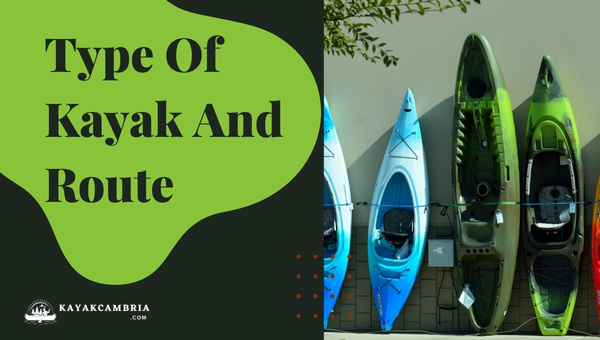
The type of kayak you choose to paddle and the route you take can greatly influence the distance you can cover in a day. Different types of kayaks serve different purposes and perform differently in various water conditions. Here, we’ll break down the main kayak types and how the chosen route can impact your paddling distance.
Different Types Of Kayaks
- Sit-On-Top Kayaks: These user-friendly kayaks are perfect for casual paddling and are commonly used by beginners. They provide great stability, but due to their wider design, don’t generally offer the same level of speed as other types of kayaks.
- Touring Kayaks: Designed for long distances, touring kayaks are narrower and longer, allowing for more efficient strokes and faster pace. Well-suited for experienced paddlers, these kayaks are ideal for exploring diverse water bodies.
- Sea Kayaks: Built specifically for open waters and coastal areas, sea kayaks offer excellent speed and maneuverability. Their design can handle rough water conditions and cover long distances, making them ideal for advanced paddlers who want to explore challenging environments.
Factors That Influence Kayak Routes
- Calm vs. Choppy Waters: Paddling on calm lakes and slow-moving rivers will allow you to cover greater distances compared to choppy waters on oceans and large rivers, where waves and currents can be obstacles. Always be cautious when paddling in challenging conditions.
- The Role of Winds and Currents: Under favorable conditions, tailwinds, and downstream currents can help propel you and conserve energy, whereas headwinds and upstream currents can hinder your progress and make you tire quickly.
- Open Waters vs. River Trails: Open water routes usually provide more straightforward navigation, while winding river trails often involve navigating around obstacles such as rocks, fallen trees, and rapids, which can slow down your overall pace.
By selecting the appropriate kayak type and route based on your skills, you can optimize your experience and cover the maximum distance possible on your kayaking expedition. Remember, it’s not all about pushing the limits, but enjoying the journey and embracing the waterways at your own pace.
Personal Fitness And Health
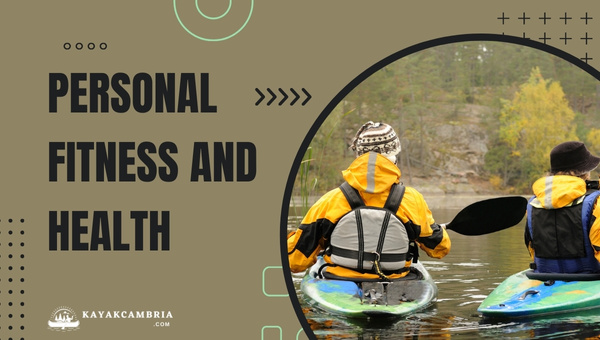
As a kayaker, regardless of experience level, it’s important to assess your current personal fitness and health when determining how far you can kayak in a day. These factors play a significant role in your paddling endurance and overall enjoyment of the water.
Physical Strength And Stamina
Strong arms, shoulders, back, and core muscles are crucial for kayakers. Those with good physical strength can maintain a more efficient paddling pace and cover longer distances. You should also take into consideration your cardiovascular fitness level, as paddling for extended periods demands endurance and stamina. Regular exercise, including cardio and strength training, helps boost your overall fitness and paddling abilities.
Age, Weight, And Prior Injuries
A paddler’s age, weight, and any prior injuries may impact their ability to kayak long distances. While kayaking is a low-impact activity that accommodates a range of age groups, it’s essential to be realistic and consider how these factors may affect your personal performance. Listen to your body and make adjustments based on your physical capabilities to ensure enjoyable and safe outings.
Paddling Speed And Pace
Maintaining a steady pace while kayaking is crucial for covering long distances. While advanced kayakers might have a faster average speed, experienced paddlers often stress the importance of finding a comfortable and sustainable rhythm when aiming for longer distances. Remember – slow and steady often wins the race!
Rest Breaks
No matter your level of fitness, it’s essential to take regular rest breaks when kayaking for an entire day. This may involve pauses to stretch, have a snack, and rehydrate. These breaks are crucial not only for your body’s recovery but also for your mental well-being on the water.
Your personal fitness and health greatly impact the distance you can cover while kayaking. By being aware of your physical abilities, developing a sustainable paddling pace, and taking adequate rest breaks, you can set realistic goals and enjoy every moment of your kayaking adventure.
Weather Conditions And Day Length
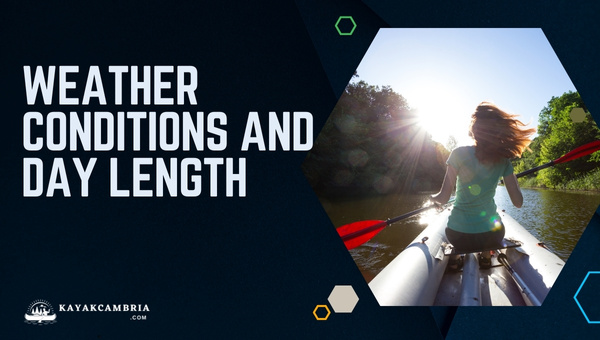
When planning to cover a specific distance while kayaking, weather conditions, and day length play a significant role in determining how far you can paddle in a day.
Impact Of Temperature And Climate
Temperature and climate can affect your energy levels, comfort, and paddling speed. Extreme conditions, such as heat waves or freezing temperatures, can make kayaking more challenging, whereas moderate temperatures allow for more comfortable and prolonged paddling sessions. Always dress appropriately for the climate, opting for quick-dry, moisture-wicking clothing, and consider carrying extra layers to adapt to changing conditions.
Encountering Rain, Snow, Fog, And Strong Winds
Paddling in adverse weather conditions such as rain, snow, fog, and strong winds presents additional challenges, such as decreased visibility, colder temperatures, or choppy waters. Navigation might become difficult, forcing you to slow down or stop entirely until conditions improve. If the weather forecast warns of any severe weather, it’s best to postpone your trip to ensure your safety.
Daylight Hours And Planning Your Route
Daylight hours are an essential factor when estimating how far you can kayak in a day. Generally, you should plan your route within the limits of available daylight, ensuring that you have enough time to return or reach your destination before dusk. Consider that daylight hours vary depending on the time of the year and your geographical location.
Additionally, in some waterways and parks, there may be regulations prohibiting kayaking during certain hours of the day or night. Checking local guidelines can help you plan accordingly and ensure you’re complying with all rules.
Here’s a summary of the key points we discussed in this section:
- Temperature and climate impact energy levels, comfort, and paddling speed.
- Adverse weather conditions (rain, snow, fog, and strong winds) could decrease visibility, increase difficulty, and affect navigation.
- Plan your route according to daylight hours and local regulations.
Planning Your Kayaking Distance
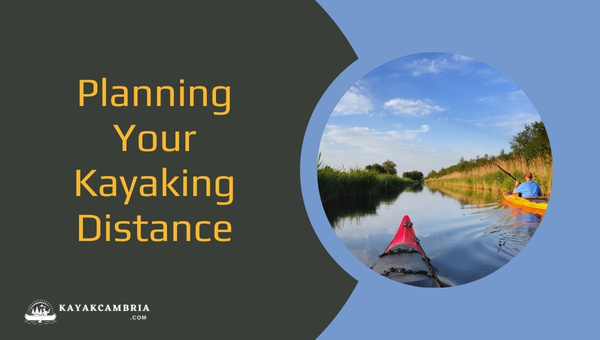
When planning a long day of kayaking, it’s crucial to take into account a few key factors. Kayaking distances are highly personal and can vary depending on an individual’s experience and fitness level, as well as external factors like weather and water conditions. Here’s how to plan the perfect distance for your next paddling adventure.
1. Assess Your Skill Level And Fitness
An important step in determining your kayaking distance is assessing your skill and experience as a paddler. If you’re a beginner, it’s best to start with shorter distances of about 5-7 miles. Intermediate paddlers, who have more experience, can typically handle distances of 10-15 miles, while advanced kayakers may be able to paddle 20 miles or more in a day.
Your fitness level also plays a significant role in the distance you can cover. Paddling requires stamina and strength, so if you’re not already in relatively good shape, you might want to focus on increasing your endurance before attempting a long-distance kayaking trip.
2. Evaluate The Route And Water Conditions
Your planned route and water conditions can greatly affect your kayaking distance. If you’re paddling in calm waters like lakes or canals, you might cover more distance than if you were navigating through rough seas or strong currents on a coastal route. Make sure to research your chosen waterway, including current, tidal patterns, and potential hazards before setting out. You should also check the weather forecast to ensure you won’t face any unexpected challenges during the day.
3. Establish Realistic Goals
While it’s normal to have ambitious goals for your kayaking adventure, it’s essential to set realistic expectations. Overestimating your abilities could lead to exhaustion, injury, or even getting lost. To set achievable distance goals, consider breaking your day into smaller segments and including rest breaks for stretching, eating, and hydration. Remember, it’s better to enjoy your time on the water and finish feeling accomplished, rather than pushing too hard and ending up frustrated or in danger.
Utilize maps and navigational tools to design your route and monitor your progress. Topographical maps, GPS devices, and smartphone apps are useful resources for paddlers. Not only can they help you plan your ideal distance, but they’ll also keep you on the course should you encounter any unexpected obstacles or detours.
When planning your kayaking distance, it’s crucial to take into account your skill level, fitness, route, water conditions, and goals. By utilizing maps, and navigational tools, and setting realistic expectations, you’ll be sure to have a successful and enjoyable day on the water.
Preparation And Training Tips For Long-Distance Kayaking
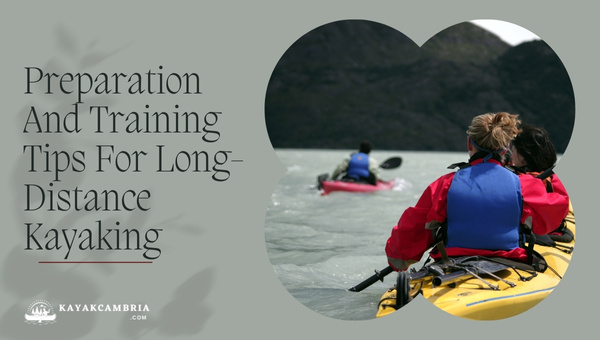
No matter your experience level, adequately preparing and training for a long-distance kayaking trip is crucial for a successful and enjoyable adventure. The following tips can help you build the necessary endurance, strength, and confidence to tackle a full day of paddling.
1. Increase Time On The Water
The best way to build your kayaking endurance is through consistent practice. Start by paddling for shorter distances and gradually increase your time on the water. This will help you familiarize yourself with your kayak, improve your paddling technique, and build the necessary muscle memory.
2. Cross-Training And Physical Conditioning
While kayaking-specific exercises are essential, incorporating cross-training and other physical activities can improve your overall fitness. Focus on activities like swimming, cycling, and running to increase your aerobic capacity and stamina. Strength training, yoga, and stretching can also enhance your flexibility and balance.
3. Nutrition And Hydration
Prioritize a well-balanced diet that fuels your body for long-duration paddling. Eating a mix of lean proteins, complex carbohydrates, healthy fats, and plenty of fruits and vegetables is essential. Remember to hydrate before, during, and after your training sessions. Dehydration can negatively impact your performance and focus.
4. Acquiring Essential Gear And Safety Equipment
Invest in the right equipment to ensure your safety and comfort on the water. Essential gear for long-distance kayaking trips includes a personal flotation device (PFD), paddle, dry bags, signaling devices, and first aid supplies. Dress according to the weather conditions and always follow appropriate safety guidelines.
5. Plan And Familiarize Yourself With Your Route
Before embarking on a long-distance kayaking trip, thoroughly research your chosen route. Obtain detailed maps and review them carefully, learn about any hazards, and identify potential rest spots and landmarks. Ask experienced kayakers or local authorities for their insights and advice.
Factors Influencing The Speed Of Your Kayak

While kayaking, one of the essential factors to consider is the speed your kayak can achieve. Numerous factors contribute to the speed and efficiency of a kayak, ultimately affecting its total paddling distance. Here, I will discuss the key factors that can influence the speed of your kayak during your journey.
1. Kayak Design & Materials
Different kayak designs, shapes, and materials can significantly impact the vessel’s overall speed. Long and narrow kayaks produce less drag and resistance in the water, ultimately resulting in higher speeds. Moreover, materials such as fiberglass or carbon fiber also contribute to increased speed, due to their lightweight and rigid structure.
Hull Shape
The shape of a kayak’s bottom can directly influence its speed and stability. There are two primary hull shapes: flat and rounded. A flat hull provides more stability and is ideal for recreational kayaking activities, while a rounded hull results in higher speeds due to reduced drag. Thus, it is crucial to choose a kayak with the appropriate hull shape tailored to your intended usage and kayak experience level.
2. Paddler’s Skill & Paddle Type
The paddler’s skill is another essential factor that affects a kayak’s speed. Efficient and powerful paddling techniques translate into greater speeds over water. Additionally, your paddle choice also plays a critical role in achieving optimal speed. Lightweight, carbon fiber paddles with larger blades are ideal for those looking to increase their speed, as they provide more propulsion with each stroke.
3. Water Conditions & Weather
Your kayaking speed is also susceptible to changes in water conditions and weather. Fast currents or a strong tailwind can boost your speed with less effort, while choppy waters and headwinds may slow you down. Planning your route according to real-time weather forecasts and understanding the impact of tides and currents can help you navigate these conditions more effectively.
4. Kayak Load & Distribution
The weight distribution in your kayak has a notable impact on its speed and maneuverability. Overloading your kayak or unevenly distributing weight can create increased drag and make it harder to paddle. By ensuring efficient weight distribution and maintaining a lighter load, you will ultimately experience enhanced kayak speed.
5. Physical Fitness & Endurance
Lastly, your physical fitness levels and endurance greatly impact the speed at which you can paddle your kayak. Building upper body strength and maintaining good cardiovascular health through regular exercise will allow you to maintain a faster pace for longer periods, which is especially beneficial for long-distance kayaking journeys.
Understanding the factors that influence your kayak’s speed is key to optimizing your kayaking experience. By selecting the appropriate kayak design and paddle type, honing your paddling skills, and taking into consideration the impact of water conditions, weather, load distribution, and your personal fitness, you can maximize the speed and efficiency of your kayak, ultimately helping you to cover greater distances during your kayaking adventures.
How Much Can You Paddle A Kayak In A Day?
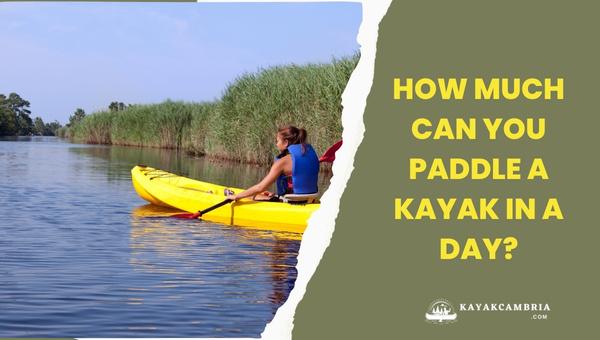
When it comes to the question of how much one can paddle a kayak in a day, there is no one-size-fits-all answer. Distances can range from just a few miles for beginners to upwards of 20-30 miles for experienced paddlers. Here, we will examine some key factors that influence this variance and provide a general idea of what to expect based on personal experience and fitness levels.
The Novice Paddler
For someone just starting out or with little kayaking experience, you can expect to cover between 5-10 miles in a day, depending on factors like weather and the type of kayak being used. It is essential to listen to your body and not push yourself too hard, as getting used to the physical demands of kayaking takes some time.
The Intermediate Paddler
As you gain experience and improve your paddling technique, you will be able to increase your daily distance. Intermediate paddlers typically cover between 10-20 miles per day, as they will have developed a better understanding of their abilities and can better gauge how long they can paddle without overexerting themselves. Practice and experience play a significant role at this level.
The Advanced Paddler
For those who are seasoned kayakers and have honed their skills, daily distances of 20-30 miles or more are achievable. These paddlers have a strong understanding of their bodies and abilities, manage their pace well, and carefully plan their routes to ensure they can cover such distances without putting themselves at risk.
Factors That Affect Paddling Distance
Regardless of your experience level, keep in mind that several factors can affect how far you can paddle in a day, such as:
- Weather conditions (wind, waves, and currents)
- The type of kayak being used (recreational, touring, sea kayak)
- The physical fitness and experience of the paddler
- Proper pacing and allowance for rests and breaks
- The route was chosen and the waterway’s conditions
While there is no set answer to the question of how far one can paddle in a single day, various factors influence the distance for each individual. By paying attention to these factors, beginners and seasoned kayakers alike can create a kayaking experience tailored to their own abilities, ensuring a safe and enjoyable paddling adventure.
How To Calculate Kayaking Distance?

Calculating the distance you can kayak in a day is a fundamental aspect of planning your paddling adventure. To estimate this distance, you can take into account the following factors:
1. Average Speed
Start by determining your average kayaking speed. This will largely depend on your fitness level, experience, and kayak type. For beginners, the average speed may range from 2-3 miles per hour (mph). Intermediate paddlers can typically achieve speeds of 3-4 mph, while experts can reach 5 mph or more.
Tip: You can measure your average speed during practice sessions or by using GPS devices specifically designed for paddlers.
2. Trip Duration
Next, consider how long you plan on paddling per day. It’s important to be realistic and include breaks for rest, meals, and sightseeing. A common recommendation is to paddle for 4-6 hours, taking breaks every hour or whenever you start to feel fatigued.
3. Distance Formula
To calculate your potential kayaking distance, simply multiply your average speed by the number of hours you intend to spend paddling:
Distance = Average Speed (mph) x Trip Duration (hours)For example, if you’re a beginner paddler with an average speed of 2.5 mph, and you plan to paddle for 5 hours:
Distance = 2.5 (mph) x 5 (hours) = 12.5 milesIn this scenario, you could expect to cover roughly 12.5 miles in a day.
4. Adjustments For External Factors
Keep in mind that the above calculation is a rough estimate. It’s crucial to adjust your expectations according to various external factors, such as:
- Weather conditions: strong winds, heavy rain, or currents may slow down your progress
- Terrain: when paddling in rivers with bends or areas with strong tides, your distance might be reduced
- Effort: if you need to portage or carry your kayak at certain points, it will take more time and energy, decreasing your overall distance
By considering all of these elements, you’ll have a more accurate estimation of the distance you can travel in a day by kayak, which in turn will help you plan a safe and enjoyable trip.
Is Fitness Necessary To Kayak Long Distances?
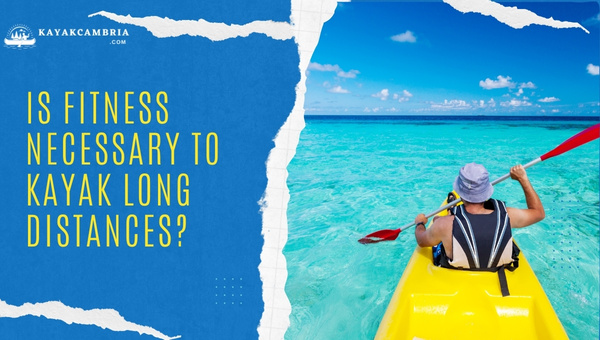
When it comes to embarking on lengthy kayaking excursions, one might wonder whether being physically fit is a prerequisite for success. The short answer to this query is that while fitness definitely plays a crucial role, it isn’t the sole determining factor when it comes to tackling long distances on the water. In this section, let’s discuss the various aspects of physical fitness that contribute to a successful kayaking adventure, as well as alternative ways to compensate for insufficient fitness levels.
Building Endurance For Long Kayaking Trips
Being physically fit in terms of endurance capacity is indeed an advantage when it comes to kayaking long distances. The ability to paddle for extended periods without experiencing significant fatigue allows for increased efficiency and speed, ultimately resulting in the successful completion of your journey. However, individuals with lower fitness levels can still enjoy long kayaking trips, provided they pace themselves and take frequent breaks to rest and recover.
Strengthening Your Core And Upper Body
A strong core and upper body are instrumental in achieving proper paddling strokes and maintaining stability in the kayak. Those with a well-developed muscular system may find it easier to paddle for longer durations, as these muscles help to support the continuous arm and torso movements associated with the activity. However, just as with endurance capacity, less physically fit individuals can compensate by adopting efficient paddling techniques and taking regular breaks.
Balance And Flexibility
While not necessarily tied to overall fitness levels, having good balance and flexibility can be highly beneficial when kayaking long distances. These attributes help in maintaining stability and posture, as well as assisting in making swift and agile movements when needed – particularly in challenging water conditions. If you don’t possess these skills, practicing yoga and other stretching exercises may prove advantageous for your kayaking endeavors.
Adapting Your Kayaking Technique
For those who may lack the ideal fitness level for kayaking, focusing on improving one’s paddling technique is crucial. By mastering efficient and energy-conserving strokes, it’s possible to bridge the fitness gap to some extent and still cover considerable distances on the water.
While being physically fit definitely provides an edge for long-distance kayaking, it is not an absolute necessity. With proper pacing, regular breaks, and attention to technique, even less fit individuals can enjoy lengthy paddling adventures. Ultimately, it’s important to listen to your body and remain aware of your personal limits to ensure a safe and enjoyable kayaking experience.
Special Case Of Tandem Kayaks
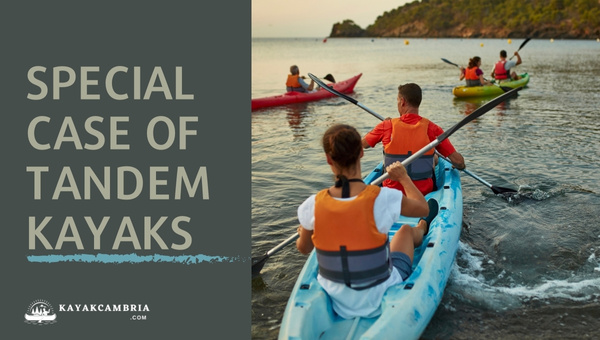
When considering the distance one can kayak in a day, we must not overlook the special case of tandem kayaks. These two-seater vessels are often used by couples, friends, or families who wish to paddle together. They offer unique advantages and challenges compared to solo kayaks. Let’s explore the factors that affect how far you can cover on a tandem kayak:
1. Enhanced Teamwork
The most striking feature of tandem kayaks is having two paddlers, which essentially means more manpower. When working in sync, paddling partners have the potential to cover greater distances more efficiently than solo kayakers. Communication and understanding each other’s strengths and weaknesses can help in efficiently dividing the workload and maintaining a steady pace.
2. Paddling Techniques And Harmony
At the same time, tandem kayaking can be challenging for those who have not yet mastered the art of paddling together. If the two kayakers are not in harmony or lack proper paddling techniques, they may counteract each other’s efforts and ultimately hinder the kayak’s overall speed and direction. Thus, it’s crucial to practice and develop a rhythm that works best for you and your partner.
3. Varying Abilities And Pacing
Additionally, covering long distances in a tandem kayak may prove difficult if the paddlers have vastly different levels of experience and fitness. In such cases, it’s vital to find a balance between the faster and slower paddlers by setting a pace that is comfortable for both. Taking regular breaks can be particularly helpful in maintaining stamina and preventing frustrations.
4. Proper Distribution Of Gear And Supplies
Lastly, another aspect unique to tandem kayaking is the need to evenly distribute the weight of gear and supplies among the paddlers. This ensures the kayak remains stable, allowing it to move and maneuver well in the water. Moreover, considering water and food consumption should be taken into account for both paddlers.
Tandem kayaking presents both challenges and advantages when it comes to covering long distances in a day. By working on your synchronization, balancing skills and strengths, and appropriately dividing gear, you and your kayaking partner can enjoy the journey and potentially cover even greater distances together than you would alone.
Challenges You May Face When Kayaking Long Distances
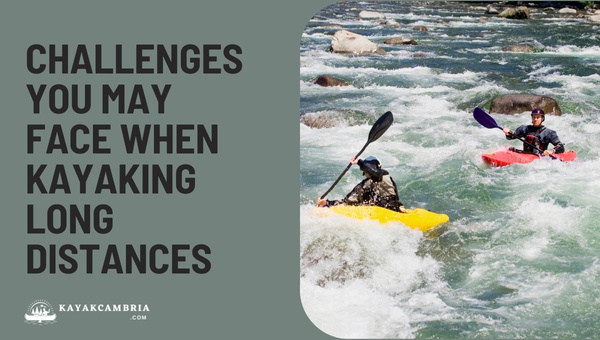
When kayaking for long distances there are some challenges you may face which are explained below:
1. Physical Fatigue
One of the primary challenges faced by paddlers during long-distance kayaking is physical fatigue. The demands of continuous paddling can put a strain on your body, especially on your shoulders, back, and wrists. It’s essential to maintain a proper paddling technique for efficient energy use and to take regular breaks when needed to avoid overexertion.
Navigating waterways during long-distance kayaking can be another challenge, as the routes may not always be well-marked or familiar. You might encounter rapidly changing currents, shifting sandbars, or unexpected obstructions. Therefore, it’s critical to remain vigilant and be prepared for the possibility of needing to adjust your course. Make use of a reliable map or GPS and consult with local paddlers for advice on navigating the waters.
3. Weather Changes
Unpredictable weather can pose a significant challenge while kayaking long distances. Sudden strong winds, rains, or even storms can dramatically impact your paddling conditions. To minimize this risk, constantly monitor the weather forecast, have a means of communication such as VHF radio, and be prepared to seek shelter if necessary.
4. Equipment Failure
Wear and tear on your kayak and gear is inevitable during long journeys. However, a broken paddle or a leaky kayak could spell disaster on a long-distance trip. It’s important to regularly check and maintain your equipment before embarking on your journey, as well as pack essential repair items to address any malfunctions.
5. Dehydration and Nutrition
Maintaining proper hydration and nutrition levels is crucial during a long-distance kayaking trip. Dehydration and low energy can negatively affect your performance and decision-making abilities. Remember to pack sufficient water and a variety of easily accessible snacks to replenish your energy levels throughout the day.
6. Accidents and Injuries
When embarking on long kayaking trips, you may experience accidents or injuries that can hinder your progress. This could include anything from a simple muscle cramp to more serious injuries caused by submerged rocks or collisions. Always carry a first aid kit on board and familiarize yourself with basic first aid practices to manage any injuries that might occur.
By understanding and addressing these challenges, you can effectively prepare yourself for the unique demands of long-distance kayaking and get the most out of your paddling adventure. While challenges are always a possibility, proper preparation and adaptability will help you safely and confidently navigate even the most daunting routes.
7. Blisters
Blisters can be a common and painful challenge faced by kayakers, especially when covering long distances. They can develop on your hands from prolonged gripping of the paddle or on your feet from wet shoes or sandals. To avoid blisters, make sure to wear gloves designed for kayaking and dry, comfortable footwear. Additionally, applying a blister prevention product or covering potential hotspots with adhesive moleskin can help protect your skin.
8. Muscle Cramps
Muscle cramps are another challenge that kayakers may encounter during long-distance paddling. They are often caused by fatigue, dehydration, or electrolyte imbalance. To reduce the risk of cramps, make sure to hydrate properly, consume electrolyte-rich foods or drinks, and warm up your muscles before paddling. In case of experiencing a cramp, take a break and gently stretch the affected muscle to alleviate the discomfort.
9. Hunger
Keeping yourself energized throughout a long kayaking journey is critical, as hunger can lead to decreased stamina and focus. It’s essential to pack and consume enough nourishment during the day to maintain your energy levels. Opt for high-calorie, nutrient-dense, and easy-to-eat snacks like energy bars, nuts, and dried fruit to keep yourself fueled and satiated.
10. Tidal and Current Challenges
When kayaking long distances, especially in coastal regions, tidal changes, and currents can present a difficult challenge. These factors could force you to paddle against strong ocean currents or find yourself in a potentially dangerous situation. Familiarize yourself with the area’s tide tables and current patterns before setting off and plan your route and timetable accordingly.
11. Boredom
While it may seem surprising, boredom can be a real challenge during long-distance kayaking trips. The repetitive nature of paddling, combined with long hours on the water, can cause your mind to lose focus and motivation. To combat boredom, bring along some entertainment like waterproof headphones and your favorite tunes or podcasts, or consider kayaking with a companion to make your journey more engaging and interactive.
Tips For Staying Safe While Kayaking in 2025
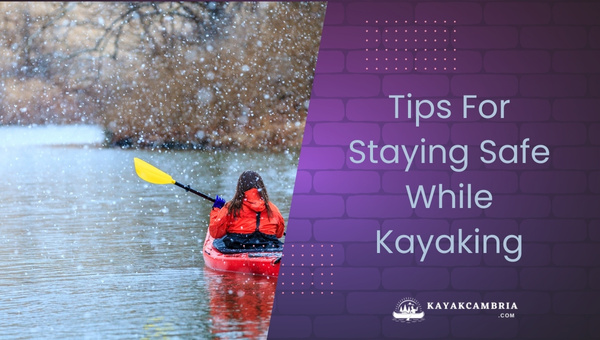
Kayaking is an enjoyable and refreshing activity for people of all ages, but it’s essential to prioritize safety. A smooth and enjoyable paddling experience is only possible if precautions are taken beforehand. Below are some crucial tips for staying safe while kayaking.
1. Choose The Right Equipment
- Select the proper kayak depending on whether you’ll be exploring calm lakes, white-water rivers, or open seas
- Invest in a comfortable, well-fitting lifevest or personal flotation device (PFD) that is approved by the relevant authorities
- Opt for a quality paddle that corresponds with your height and kayaking style
2. Pay Attention To The Weather
- Always check the weather forecast prior to embarking on your kayaking adventure to avoid getting caught in storms, strong winds, or heavy rain
- Familiarize yourself with the local tides and currents to help plan your route more efficiently
3. Dress Appropriately
- Wear quick-drying, moisture-wicking clothes made from synthetic fabrics or wool; avoid cotton, which takes longer to dry and can make you feel cold when wet
- If kayaking in cold water, consider using a wetsuit or drysuit to prevent hypothermia
4. Learn Basic Paddling Techniques And Safety Skills
- Enroll in a kayaking course to learn essential paddling techniques and acquire valuable safety knowledge
- Master the steps to perform an effective and safe wet exit from your kayak, should it capsize accidentally
- Practice self-rescue and assisted rescue techniques to deal with emergencies that may occur while kayaking
5. Maintain Proper Communication
- Always inform a friend, family member, or the local authorities about your kayaking plan, route, and expected return time
- Carry a whistle, marine radio, or cell phone (in a waterproof case) to communicate with fellow paddlers or summon help, if needed
6. Be Vigilant And Aware
- Keep a safe distance from motorized watercraft, as their drivers might not always see you, and be mindful of swimmers in the area
- Stay vigilant while paddling, and watch out for other sea creatures, obstacles, and potentially hazardous water conditions
By following these essential safety tips and being well-prepared, you can enjoy your kayaking adventure to the fullest while minimizing risks. A vigilant paddler is a safe and content paddler, so always prioritize your well-being and that of your fellow kayakers.
Frequently Asked Questions
1. How many miles can an average person kayak in a day?
An average person with moderate experience can typically kayak between 10 to 20 miles per day. However, this number depends on factors such as weather conditions, paddling technique, personal fitness levels, and the type of kayak being used. [Weather conditions], for instance, play a significant role in determining your kayaking speed and distance.
2. How do I improve my kayaking endurance to paddle longer distances?
To improve your kayaking endurance, focus on increasing your overall fitness levels by regularly incorporating cardiovascular and strength training exercises into your routine. Additionally, work on refining your paddling technique through practice and training sessions with experienced kayakers. Ensuring proper nutrition and staying hydrated will also help improve your endurance.
3. What should I pack for a long-distance kayaking trip?
For long-distance kayaking trips, it’s vital to pack essentials such as sufficient water and food, extra clothing layers, a hat, sunscreen, sunglasses, a waterproof map of the area, a fully-charged phone in a waterproof case, a [first aid kit], and a personal flotation device (PFD). Additionally, don’t forget to bring repair materials for your kayak, such as a spare paddle and duct tape.
4. Is kayaking safe for beginners?
Yes, kayaking can be safe for beginners, provided they choose calm waters and an appropriate kayak for their experience level. It’s also crucial for beginners to become acquainted with essential safety procedures, such as how to perform a [wet exit], the proper use of a PFD, and an understanding of local water conditions. It’s also highly recommended that beginners take introductory kayaking courses or enlist the guidance of an experienced kayaker.
5. How do I maintain a consistent paddling speed while kayaking?
To maintain a consistent paddling speed, focus on developing and utilizing efficient paddling techniques. Keep your strokes smooth, relaxed, and synchronized with your torso rotation to reduce energy expenditure. Engage your core to improve balance and reduce strain on your arms and shoulders. As you learn to paddle more effectively, you’ll find it easier to maintain a steady speed over longer distances.
Conclusion
The question of how far you can kayak in a day is a multifaceted one, as various factors influence the outcome. These include one’s physical fitness, experience, the type of kayak, paddling techniques, weather conditions, and the essential practice of pacing oneself. By carefully considering each aspect, you can optimize your paddling adventure and push yourself to new limits, all while maintaining safety and well-being.
- Be honest with yourself about your physical condition and kayaking expertise, and utilize this information to set achievable goals.
- Select the appropriate type of kayak for your specific journey, taking note of their speed and stability features.
- Work on proper paddling techniques to improve efficiency and reduce fatigue.
- Keep a close eye on real-time weather forecasts and tide tables, and plan your route accordingly.
- Allocate plenty of time for rest and refreshment during your excursion. Remember that slow and steady often wins the race!
- Make contingency arrangements in case of unforeseen obstacles or changes in the weather.
By following these guidelines, you’re well on your way to discovering and enjoying all that the open water has to offer. So, harness your paddles and embark on a memorable kayaking experience – one that respects your unique abilities and aspirations.

